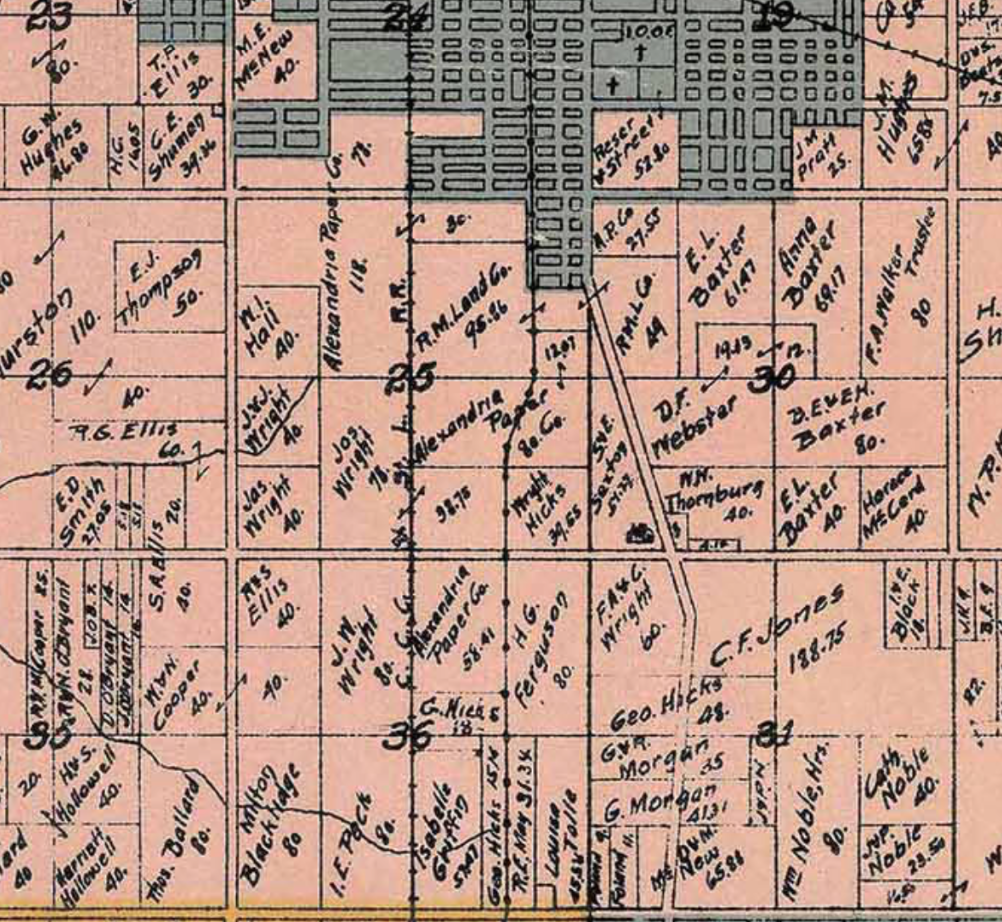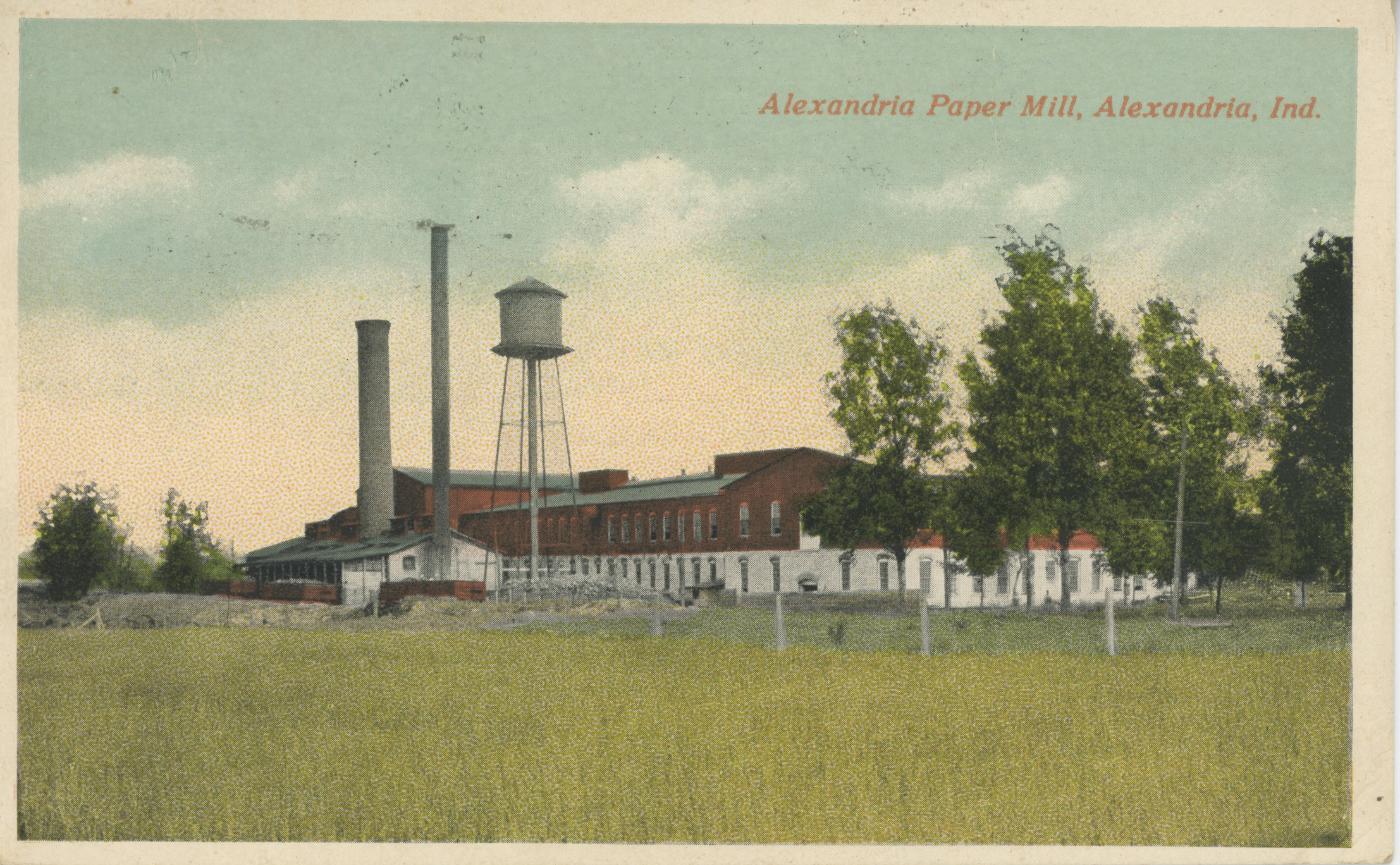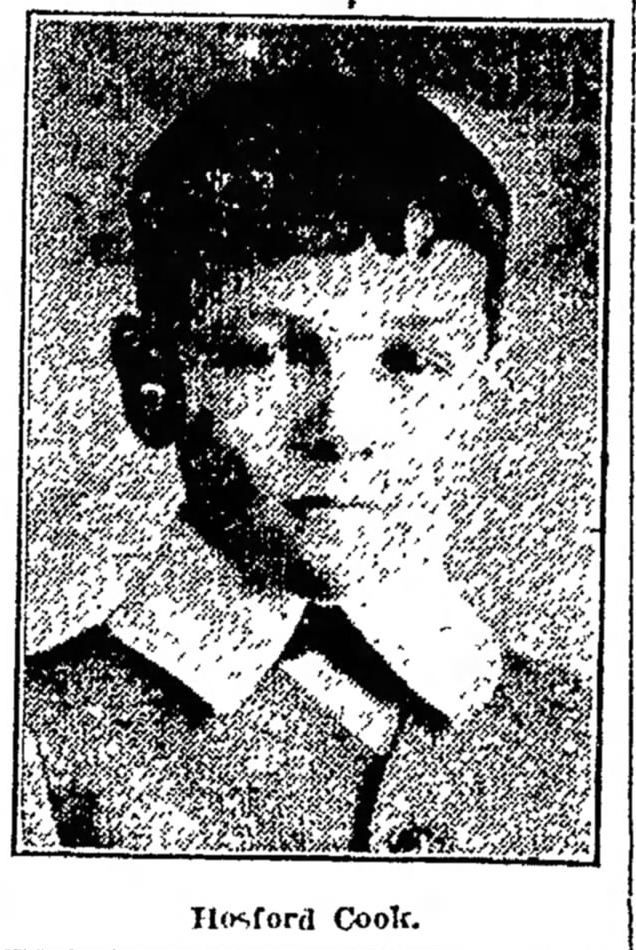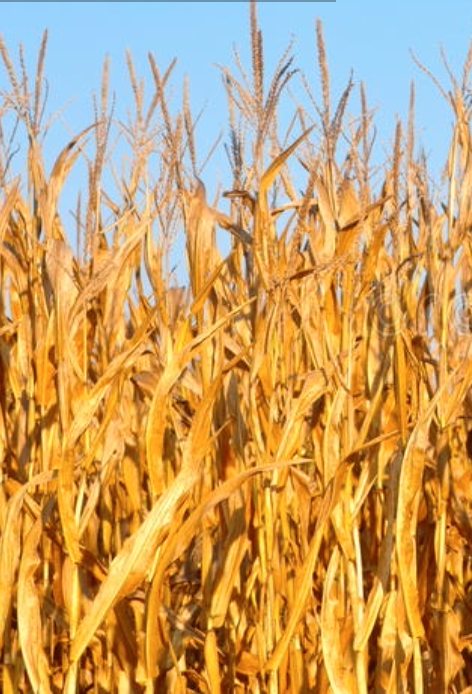The Alexandria Paper Company 1919-1930
The rich farmland of Madison County played a role in choosing the location for the Alexandria Paper Mill in 1899. S. A. may have been a serial entrepreneur by day, but farming was still strong in his blood. Over the years he slowly added additional acreage to the original 30 purchased to support the mill. This land was divided into small farm plots which were rented on a stock sharing basis. These farm plots supported a balanced crop rotation, along with the raising of livestock including hogs, beef and dairy cattle, sheep, poultry, and horses. He called this land the Alpaco Farms (Alexandria Paper Company Farms).
The seven hundred acres of the Alpaco Farms were located in Madison and Delaware counties. The buildings were painted in the same color scheme on every farm. Farm dwellings were painted white, while the barns were red with white trim. [1]
The farms provided a way of life and income for some Alexandria families, it was the Alexandria Paper Company that was the “pride of the community,” employing about 150 men and women. It was a “good place to work” as employees were “treated right under every and all circumstance.” [2]
Leading the company founded by his father, S. A. Cook, was Harry Cook, president, and general manager; his brother-in-law Charles Lancaster, vice-president; Edwin Yule, secretary-treasurer; and William Brannon superintendent.
Harry was in Chicago, Illinois when the news came over the wire that the Armistice had been signed. The fighting of World War I had stopped. Upon hearing the news, Harry “got into immediate connection with the Alexandria paper mill and gave instructions to tie down the big whistle and let her blow.” [3]
As the men started to return, they were welcomed home with open arms by their families. At the first call for men to go to war, the paper mill had established a rule “that all good workmen would be taken back when they returned from war.” Harry stated that no distinction would be made “between the enlisted and the drafted man.” [4] The men of Alexandria found their jobs waiting for them upon arriving home.
In June 1919 the Alpaco Farms, and the farmers of Madison County brought their wool to market. “A noticeable feature of the delivery of the wools [3,300 pounds], was the fact that only one wagon was used. All the farmers with the exception of one used automobiles to carry the wool to Alexandria.” [5]
The corn was not “knee high by the 4th of July” in the cornfield on West Eleventh Street, where no corn would grow on a patch of land measuring 40’ x 60.’ “Thereby hangs a tale. Over ten years ago a saloon did a thriving business at this place and business was good on account of the large number of customers from the Alexandria steel factory. The conclusion is reached that the owner of the bar emptied bags of beer in the rear of the saloon building,” and now nothing will grow on this patch. [6]
1920 looked to be a profitable year at the paper mill. Harry, in Florida, still convalescing from sleeping sickness was in frequent communication with mill superintendent, William Brannon. With this promising forecast, he implemented a 12 1/2% wage increase for all employees, both in the factory and the office. [7]
Harry’s road to recovery was long. In April 1921 he left Florida heading for New York, spending the next year and a half in Southold on Long Island. By October 12, 1922, he had recovered sufficiently to return to Alexandria, arriving in a “special Pullman” railway car, accompanied by Ed Yule, with Charles and Maud Lancaster. [8] I believe this to be the last extended visit he made to Alexandria. By January, Harry had returned to Florida, [9] and in 1924 settled in Atlantic City, New Jersey.
While the doctors were unable to find a cure for Harry’s sleeping sickness, the Yule’s were so grateful for the advance in medicine when on April 4, 1923, Georgina was rushed to Anderson for an emergency appendectomy. She came through the “ordeal in splendid shape” and the doctor “looked for no complications to set in.” [10]She was able to return home 25 days later on April 29th, and “her complete recovery from her recent operation is only a matter of a short time.” [11]
The summer storm that rolled through Alexandria on the morning of June 28, 1924, headed straight for the paper mill. William Brannon reported that “a sudden windstorm came upon us at 7:30 this morning and by the time it reached our mill it had assumed the form of a ‘twister.’” The twister hit the “huge steel smokestack that towered a hundred feet or more skyward” and “was struck by a hard wind about ten minutes before 8 o’clock this morning and fell with a crash. It broke in the middle, the top half smashing through the roof of the coal house, while the lower half fell against the big brick chimney, where it is now resting.” No other damage was done, and work began immediately to remove the stack and erect a new one. [12]
1925 started with a lawsuit. The Citizens National Back of Newcastle, as guardian for Harry, filed a $200,000 suit against Charles and Maud, alleging that they had “fraudulently obtained possession” of 500 shares of Harry’s stock in the Alexandria Paper Company. To read more about the suit and Harry’s guardianship, please read “She Was Hopeful Till the End – Part 1.”
On September 3rd fire ripped through the paper mill. A bearing in a rolling machine overheated which started a blaze that “ignited felt roller coverings” and “set fire to some material in a pit under the machine and quickly spread to the roof of the building.” The fire department, quick to respond, found the employees had “formed themselves into a fire brigade and held the flames in check” until the fire department arrived. But the true hero was the automatic sprinkler system installed at the mill, which “worked to perfection.” Superintendent William Brannon, and Ed Yule, now serving as general manager, reported that the mill would continue to operate while repairs were made. “This was the first time in 23 years that the city fire department was called to the paper mill to extinguish a fire.” [13]
Martha and Hosford were spending the winter of 1927 with family and friends in Naples, Florida. The day of February 16th dawned warm sunny, and they were spending the day at the beach. Hosford was playing in the surf with other children when he “got out too far and was drawn out into the Gulf of Mexico by the undertow of waves.” [14] Unable to rescue him, Hosford drowned. The news reached her parents as Martha prepared to accompany her son’s body to Oshkosh. Following a private family funeral, Hosford was placed to rest in the Paine Mausoleum in Riverside Cemetery. [15]
The sudden death of his son prompted Harry, now living permanently in Atlantic City to write a codicil to his Last Will and Testament. He changed the beneficiary list bequeathing $15,000 to his caretaker, Jessie C. Duncan, which was in addition to all payments due her for services, and the remainder to his sister,” Maud Lancaster. [16] Upon his death, in addition to his portion of his father’s estate, Maud would be in full control of the Alexandria Paper Company and all of its land holdings in Alexandria and elsewhere. A wealthy woman made even wealthier.
The climate of the paper industry was changing, and the demand for newsprint was on the decline. Many plants were switching their manufacturing to other types of paper or closing their doors. In October 1928, the Alexandria Paper Mill closed, with the final order shipping on November 9th. [17] “Jake Miller the last engineer of the plant, shed tears of sadness when he blew the company whistle for the last time.” [18]
Corn stalk pulp. As paper mills were seeing a change in the need for newsprint, the government was experimenting with making paper from corn stalk pulp. [19] With the Alexandria Paper Company so recently closed, the Chamber of Commerce moved quickly into action by contacting the Department of Agriculture to see if they would be interested in the mill for their experiments “with corn stalks and other growths for the manufacture of paper.” The Chamber believed that “Alexandria is a very favorable place for some of the experiments, especially in making paper from corn stalks, on account of the abundant supply of the raw material which may be obtained near at hand.” [20]
In March 1929, the Agricultural Department of the Chamber of Commerce of the United States published their findings. The report stated that wood could be grown and harvested on a large scale by few producers, whereas the use of corn stalks would require a large initial capital investment in a raw material that is “dependent upon thousands of individual producers as in the case of corn stalks,” making the process of turning corn stalk pulp into paper not “applicable on a commercial scale.”
The quest to use corn stalks for paper products continued to be a topic of discussion. A year later, in March of 1930, a representative from a “group of men who wish to obtain control of the local factory for the manufacture of wall board from corn stalks” was in Alexandria to look at the paper mill as a possible production facility. [21] While in town the representative met with the Better Business Bureau and Ed Yule to discuss the proposal. “Nothing definite developed from either of these conferences” as it was “indicated that it would be necessary for the citizens of Alexandria to purchase stock in the proposed company to the extent of $100,000, which would be 49% of the capital stock. In return for their investments, the local stockholders were to have majority on the board of directors.” [22] The citizens of Alexandria were not prepared to make such a large investment in an experimental project.
SOURCES:
- “Farm News,” The Muncie Evening Press, 17 Sep 1935, Tuesday, p. 3, col. 5; digital images, Newspapers.com (www.newspapers.com : accessed 21 Dec 2017).
- The Times-Tribune, 1 Dec 1919, Monday, p. 2, col. 1-2; digital images, Newspapers.com (www.newspapers.com : accessed 20 Jun 2016).
- “Pandemonium is Turned Loose When News Came From State Department.,” The Times-Tribune, 11 Nov 1918, Monday, p. 1, col. 1; digital images, Newspapers.com (www.newspapers.com : accessed 20 Jun 2016).
- “Men Discharged From Army Find Old Positions,” The Times-Tribune, 18 Feb 1919, Tuesday, p. 1, col. 4; digital images, Newspapers.com (www.newspapers.com : accessed 15 Jul 2016)
- “Farmers Sell Wool Clip Here This Morning,” The Times-Tribune, 25 Jun 1919, Wednesday, p. 1, col. 5; digital images, Newspapers.com (www.newspapers.com : accessed 19 May 2016).
- “Beer Saloon Is Blamed for the Failure of Corn,” The Times-Tribune, 9 Jul 1919, Wednesday, p. 1, col. 7; digital images, Newspapers.com (www.newspapers.com : accessed 20 Jun 2016).
- “Paper Mill Employes Receive Wage Increase,” The Times-Tribune, 1 Apr 1920, Thursday, p. 1, col. 2; digital images, Newspapers.com (www.newspapers.com : accessed 27 May 2016).
- “Alexandria,” The Muncie Evening Press, 13 Oct 1922, Friday, p. 6, col. 2; digital images, Newspapers.com (www.newspapers.com : accessed 1 Dec 2017).
- “Kittinger Has Counsel Here,” The Elwood Call Leader, 12 Jan 1923, Friday, p. 8, col. 2-3; digital images, Newspapers.com (www.newspapers.com : accessed 15 Jul 2016).
- “Mrs. Yule Undergoes Operation And Is Reported As Improving,” The Times-Tribune, 4 Apr 1923, Wednesday, p. 1, col. 3; digital images, Newspapers.com (www.newspapers.com : accessed 20 Jun 2016).
- “Mrs. E. W. Yule is Home From St. John’s Hospital,” The Times-Tribune, 30 Apr 1923, Monday, p. 1, col. 2; digital images, Newspapers.com (www.newspapers.com : accessed 24 May 2016).
- “‘Twister’ Hits Big Steel Smokestack Paper Mill,” The Times-Tribune, 28 Jun 1924, Saturday, p. 1, col. 2; digital images, Newspapers.com (www.newspapers.com : accessed 10 Jun 2016).
- “Fire Damages Big Paper Mill Last Evening,” The Times-Tribune, 4 Sep 1925, p. 1, col. 6; digital images, Newspapers.com (www.newspapers.com : accessed 5 Jun 2016).
- “Get Details of Death,” The Oshkosh Daily Northwestern, 18 Feb 1927, Friday Evening, p. 4, col. 2; digital images, Ancestry.com (www.ancestry.com : accessed 26 Mar 2003), Newspapers & Publications.
- A Child Lost
- “Cook’s Sister Gets Large Part of His Estate,” The Times-Tribune, 11 Aug 1931, Tuesday, p. 1, col. 5; digital images, Newspapers.com (www.newspapers.com : accessed 19 May 2016).
- Interstate Commerce Commission, Decisions of the Interstate Commerce Commission of the United States. February-July 1933 (Washington, D.C.: United States Government Printing Office, 1933), 194: 615. Cit. Date: 20 Sep 2021.
- Sue Marston, “Old Paper Mill Will Again Have A Heart Beat,” The Times-Tribune, 15 Apr 1970, Wednesday, p. 8; digital images, Newspapers.com (www.newspapers.com : accessed 19 May 2016).
- “Making Paper From Corn Stalks,” The Times-Tribune, 20 Dec 1928, Thursday, p. 2, col. 1-2; digital images, Newspapers.com (www.newspapers.com : accessed 20 Jun 2016).
- “Wait Further Information On Paper Making,” The Times-Tribune, 9 Feb 1929, Saturday, p. 1, col. 2; digital images, Newspapers.com (www.newspapers.com : accessed 4 Jun 2016).
- “Seeking Paper Mill As Factory For Wall Board,” The Times-Tribune, 3 Mar 1930, Monday, p. 1, col. 6; digital images, Newspapers.com (www.newspapers.com : accessed 4 Jun 2016).
- “Wall Board Plan Fails to Obtain Response Here,” The Times-Tribune, 12 Mar 1930, Wednesday, p. 1, col. 7; digital images, Newspapers.com (www.newspapers.com : accessed 4 Jun 2016).




